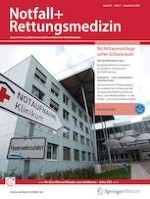05.10.2023 | Leitthema
Alarmierungskriterien für den nichttraumatologischen Schockraum – erstes Resümee nach Einführung definitiver Kriterien (V2iSiOn-Kriterien) in Münster
Erschienen in: Notfall + Rettungsmedizin | Ausgabe 7/2023
Einloggen, um Zugang zu erhaltenZusammenfassung
Alarmierungskriterien für die Schockraumanmeldung gab es bis vor Kurzem ausschließlich für Traumapatient:innen. Sie basierten lange Zeit hauptsächlich auf Verletzungsmustern und Unfallmechanismen. Vitalparameter spielten nur eine untergeordnete Rolle. Das kürzlich erschienene Weißbuch zur „Versorgung kritisch kranker, nicht-traumatologischer Patienten im Schockraum“ listet erstmals symptombasierte Indikatoren für die Schockraumversorgung nichttraumatologisch kritisch kranker Patient:innen auf. Sowohl das Weißbuch als auch die neueste Version der S3-Leitlinie „Polytrauma/Schwerverletzten-Behandlung“ empfehlen eine Schockraumversorgung auf der Basis verschiedener pathologischer Vitalparameter. Die alternativen V2iSiOn-Alarmierungskriterien basieren auf einem minimalen Set objektivierbarer und zugleich hochrelevanter Vitalparameter zur Identifikation nichttraumatologischer Patient:innen mit Indikation zur Schockraumversorgung (V2iSiOn: Vasopressor erhalten? Ventilation begonnen? Systolischer Blutdruck < 90 mm Hg? O2-Sättigung unter Raumluft < 90 %? Nichtnormales Bewusstsein/Glasgow Coma Scale < 15 Punkte?). Im vorliegenden Übersichtsbeitrag werden Gemeinsamkeiten und Unterschiede der verschiedenen traumatologischen und nichttraumatologischen Alarmierungskriteriensysteme dargestellt. Darüber hinaus wird eine erste Bilanz nach Einführung der V2iSiOn-Alarmierungskriterien in der Stadt Münster gezogen.
Anzeige














